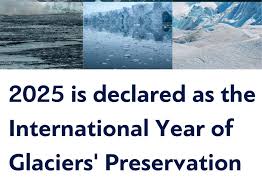Preserving Glaciers: A Cry for Climate Justice and Water Security

- 01 Jun 2025
In News:
In 2025, the United Nations has declared the year as the International Year of Glaciers’ Preservation, underscoring the urgent global need to address the retreat of glaciers. This critical issue was the focus of the International Conference on Glaciers’ Preservation held in Dushanbe, Tajikistan, co-hosted by the Republic of Tajikistan with the support of the UN and attended by leaders and experts from across the globe.
Glaciers, often referred to as the “water towers of the world”, store nearly 70% of Earth’s freshwater. However, accelerating glacier melt—driven by global warming—has become a slow-moving catastrophe. Since 1975, over 9,000 billion tons of glacial ice have been lost. The period from 2022 to 2024 marked the highest recorded glacier mass loss, with many smaller glaciers projected to vanish entirely within this century. This phenomenon threatens not only mountain ecosystems but also global water security, food systems, biodiversity, infrastructure, and human livelihoods.
Developing countries, particularly those in Asia, Africa, and Latin America, face disproportionate vulnerabilities due to glacier retreat. Communities dependent on glacier-fed rivers for drinking water, irrigation, and hydropower are witnessing increased poverty, forced migration, and infrastructure damage. Melting glaciers also contribute significantly to sea-level rise, placing coastal cities and low-lying regions at risk of displacement and flooding, as seen in Nigeria’s Niger Delta and Lagos.
The conference served as a clarion call to transition from pledges to concrete action. It recognized that 83% of global emissions that require mitigation lie with just 35 countries, emphasizing the need for collective ambition. The summit also launched the Decade for Cryosphere Science (2025–2034) and advocated for the establishment of a UN Glacier Preservation Fund to ensure sustained, long-term financing for adaptation.
Key recommendations included:
- Integration of glacier preservation into national climate policies, especially Nationally Determined Contributions (NDCs) and National Adaptation Plans (NAPs).
- Development of early warning systems and predictive tools for climate-related disasters in mountainous regions.
- Investments in data-driven adaptation, using AI and hydrological models to forecast risks and optimize resilience strategies.
- Promotion of gender-inclusive water governance, especially involving women in glacial and water-related decision-making.
- Establishment of hydro-meteorological services for glacier-dependent regions to safeguard water access and ensure resilience.
The Deputy Secretary-General of the UN stressed that resilience pays — every dollar spent on adaptation strengthens economies, protects livelihoods, and mitigates future losses. The upcoming Fourth UN Conference on Financing for Development in Seville and COP30 in Brazil were identified as critical moments to elevate financing and policy commitments.
In conclusion, glacier loss is not merely an environmental concern but a humanitarian and developmental crisis. The protection of glaciers is central to achieving SDG 6 (Clean Water and Sanitation) and must be addressed with the urgency, equity, and international solidarity it demands. The world must act now—so that future generations do not inherit a planet where glaciers and the lifelines they sustain have become a relic of the past.
